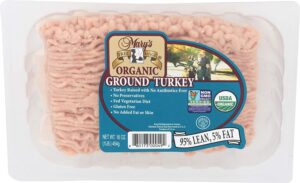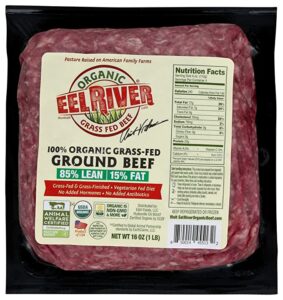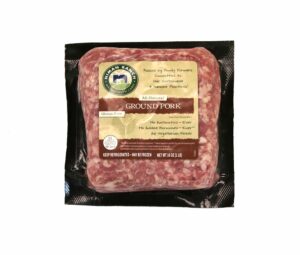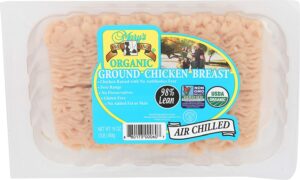Overview
Baby meatballs may be small enough to fit in your baby’s hands, but they’ll pack a punch when it comes to nutritional value. Meatballs are nutrient-dense and filled with protein, iron, the good kind of saturated fat, and cholesterol which are essential to the brain development of babies under two years old. (1)(2)
We’ve got the perfect meatball recipe that’s nutritious, quick, and so easy to prepare. It’s also convenient because it’s freezer-friendly and can be shared with the whole family.
Baby-Led Weaning – What Is It?
Baby-led weaning (BLW) skips traditional purée spoon-feeding and allows your little one to self-feed appropriately-sized finger foods. BLW promotes independence by giving your baby more control over what and how much they eat.
When Can Babies Eat Meat?
There’s no reason to hold back on meat if it’s prepared correctly. You can introduce meat as part of your baby’s first foods or when they’re already comfortable eating solid foods.
The AAP (American Academy of Pediatrics) suggests giving solids for the first time to your baby at six months old, as long as your baby shows signs of readiness. (3)
Top Reasons To Serve Meat In BLW
Meat is a good baby food choice because it’s versatile and can be served in many ways. It’s also rich in iron, calcium, B vitamins, vitamin A, all nutrients that are essential to your baby’s growth and development. Meat is a good source of heme iron that’s more easily absorbed by the body. (4)(5)
You can check our full guide on the safe introduction of meat according to baby-led weaning.
Safety Tips
When cooking meat, the following tips can help ensure your baby’s safety:
- Always cook meat thoroughly. Harmful bacteria like E. coli can live in undercooked or raw meat and cause illnesses like diarrhea, vomiting, or food poisoning. (6)
- When defrosting meat, you can submerge it under cold water with the packaging still on or keep it in the fridge overnight in an airtight container. (7)
- Baking, broiling, steaming, stir-frying are better than frying because they help preserve the meat’s nutrients. (8)
The Best Cooking Temperatures
- Beef, and pork: Cook at 160 F or higher (9)(10)
- Lamb: Cook starting at 145 F to 160 F (11)
- Chicken and turkey: Cook 165 F or higher (12)(13)
How Do You Serve Meatballs For Baby-Led Weaning:
4-6 Months
You can cut meatballs in halves, but it has to fit in your baby’s hands. This way, your baby gets a firm hold of the meatball, lessening the risk of choking.
6-9 Months
You can still offer halved meatballs or in two to three-inch strips by this age.
9-12 Months
Most babies have developed their pincer grasp, the ability to hold objects between their thumb and pointer finger. This will allow your baby to pick up smaller pieces of meatballs. If your baby is still uncomfortable picking up small pieces, it’s okay. Each baby develops at their own pace. Continue to offer halved meatballs or cut-up pieces.
12+ Months
At one-year-old, cut-up or bite-sized pieces are still safer for your baby. You can even let your baby practice picking up pieces using a fork.
Mama O’s Savory & Healthy Meatballs
Reasons To Love This Recipe
Straight from our Editor-In-Chief’s kitchen, this baby meatballs recipe has been tested and approved by her strictest judge, her baby girl Sofía.
It’s baby-friendly because it’s soft and tender enough to chew. It also helps open your baby’s taste buds to various seasonings and flavors.
It’s nutritious because it’s loaded with veggies and herbs and the phytonutrients that these offer.
Prep time: 10 minutes
Cooking time: 30 minutes
Total time: 40 minutes
Main Ingredients
Whenever possible, choose certified organic ingredients, and your chosen meat should be grass-fed or pasture-raised. This is to help ensure that your baby gets optimal nutrition with minimal exposure to possible antibiotics, pesticides, and harmful toxins.
- 1 lb of ground meat of choice (ground beef, pork, chicken, or lamb)
- 1 teaspoon ground cumin
- 1/2 teaspoon ground black pepper
- 2 cups cooked spinach
- 1 cup finely chopped and well-cooked red bell pepper
- ¼ cup finely chopped basil
- 1/4 cup finely chopped parsley
- 1 egg
Procedure
- Preheat oven to 350 F.
- In a bowl, combine the ground meat of your choice with the egg and the rest of the spices.
- In a separate pan, sautee and thoroughly cook the veggies – spinach and red bell pepper in olive, coconut, or avocado oil.
- Add the cooked veggies and chopped herbs and mix well into the meat, eggs, and spices.
- Form into mini meatballs that’ll fit into your baby’s little hands.
- Place the meatballs on top of parchment paper on a baking sheet.
- Bake at 350 F for 30 minutes or until fully cooked.
- To check, insert a toothpick in the meatball’s center. If it comes out clean, they’re fully cooked.
Substitutes
This recipe calls for an egg, which is a common allergen. If your baby has an egg allergy, you can opt for egg substitutes. You can mix 1 tbsp chia seeds or ground flax seeds with 2 ½ tbsp water until it becomes sticky.
It’s best to consult a pediatrician or registered dietitian when introducing allergens to your baby.
Foods You Can Add To Your Meatballs
Shake up your meatballs by adding some of these flavors and textures:
- Ground turkey to make turkey meatballs
- Mashed sweet potato
- Chopped zucchini
- Grated carrots
- Parmesan cheese
- Mild spices like oregano or cilantro
Food Safety With Meatballs
Are Meatballs A Choking Hazard?
Tough or large chunks of meat are included in the USDA (United States Department of Agriculture) list of common choking hazards. (14)
To reduce the risk of choking, your meatballs should be soft to eat and cut appropriately. Always supervise your baby while they’re eating.
Are Meatballs An Allergen?
Meat allergy is considered uncommon. However, there’s a type of allergy to red meat caused by a Lone Star tick. Most meatballs also contain common allergens such as eggs and breadcrumbs containing gluten.
You can substitute the egg and go gluten-free by removing the breadcrumbs. It’s best to seek the advice of your baby’s pediatrician or registered dietitian before introducing allergens.
Storage Instructions
Keep meatballs in airtight containers or freezer bags.
- In the refrigerator: One to two days (15)
- In the freezer: One to two months (15)
Our Top Recommended Choices
Ground Beef
PRE 100% Grass Fed & Finished Ground Beef
Kirkland Signature Organic Ground Beef
Eel River Organic Beef 100 % Organic Grass Fed Ground Beef
Thrive Market Grass-Fed Ground Beef

Ground Pork
Niman Ranch Ground Pork
Thrive Market Organic Ground Pork
Ground Turkey
Mary’s Organic Turkey

Ground Chicken
Mary’s organic ground chicken breast
Best Bundle Value
Butcher Box Ground Beef

FAQs
How Do I Give My 6-Month-Old Ground Beef?
There are many ground beef recipes you can try. You can stir-fry ground beef with veggies and let your baby dig in and get messy. You can also turn ground beef into meatballs or burger patties, which are easier to hold.
Can My 9-Month-Old Baby Eat Ground Beef?
Absolutely! You can offer ground beef or any meat as soon your baby is starting solid foods.
REFERENCES:
- https://kidshealth.org/en/parents/fat.html
- https://fdc.nal.usda.gov/fdc-app.html#/food-details/171638/nutrients
- https://www.cdc.gov/nutrition/infantandtoddlernutrition/foods-and-drinks/when-to-introduce-solid-foods.html
- https://raisingchildren.net.au/teens/healthy-lifestyle/nutrients/vitamins-minerals
- https://www.cdc.gov/nutrition/infantandtoddlernutrition/vitamins-minerals/iron.html
- https://www.cdc.gov/foodsafety/communication/ecoli-and-food-safety.html
- http://www.meatsafety.org/ht/d/sp/i/26023/pid/26023
- https://www.wcrf-uk.org/our-blog/what-is-the-healthiest-cooking-method/
- http://www.meatsafety.org/ht/d/sp/i/26030/pid/26030
- http://www.meatsafety.org/ht/d/sp/i/26031/pid/26031
- https://ask.usda.gov/s/article/What-are-cooking-times-for-lamb
- http://www.meatsafety.org/ht/d/sp/i/26033/pid/26033
- http://www.meatsafety.org/ht/d/sp/i/26032/pid/26032
- https://www.cdc.gov/nutrition/infantandtoddlernutrition/foods-and-drinks/choking-hazards.html
- https://www.canr.msu.edu/news/keeping_your_babys_food_safe


















